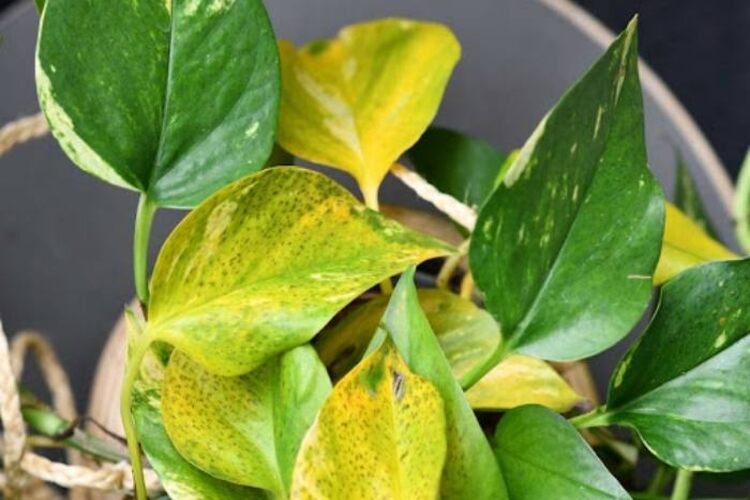Sign up for our newsletter
Get Swipe Garden's independent reviews, and expert advice sent straight to your inbox.
For information privacy practices, read our Privacy Policy.
Sign up for our newsletter
Get Swipe Garden's independent reviews, and expert advice sent straight to your inbox.
For information privacy practices, read our Privacy Policy.
Sign up for our newsletter
Get Swipe Garden's independent reviews, and expert advice sent straight to your inbox.
For information privacy practices, please read our Privacy Policy.

Yellowing leaves are signs that your pothos are not in good condition. Unfortunately, this is a common issue for many houseplants and makes gardeners’ heads spin.
There are several potential causes for yellow leaves on your pothos plant, including some problems with watering, light, temperature, humidity, soil pH, overfertilization, nutrient deficiencies, pests, and disease.
You can eliminate the problem and give your pothos back their inherent healthy look with proper care and treatment. This article will discuss the causes of yellow leaves on Marble Queen pothos and how to fix the problem.
Marble Queen Pothos is a type of pothos with variegated leaves in shades of green and white. The Marble Queen with a yellowing leaf signifies that it is in trouble. The leaves on the plant will turn discoloration and may eventually fall off as a result. If this happens, it is vital to find the cause immediately, or else your baby plant could die.
The most common reasons for this problem are:

If your Marble Queen plants are starting to show yellow leaves, there are a few things you can do to try to revive them.
Watering is a substantial factor contributing to the degradation of the Pothos, though fixing it would be easy enough to change the situation. Avoid using an automatic timer and only give your plant some water when you see enough dry ground below so as not to overwater these delicate leaves.
When watering your plant, try to water it slowly and carefully from above so that the water can soak into the roots. Allow any excess water to drain from the holes in the pot. To keep your plant thriving through the year, you’ll need a watering plan that varies depending on the season. In spring and summer, when plants are thirstiest, you should thoroughly water them.
However, in the winter, you should allow the soil to dry out almost entirely before watering again. This will help prevent your plant from developing discoloured leaves and root rot.
The Marble Queen is a tropical plant that thrives in bright, indirect sunlight. When your pothos is not receiving enough light, there is a high chance that its leaves will turn yellow.
Make sure to place your plant near a window where it can receive plenty of sunlight. However, avoid placing it in direct sunlight, as this can scorch the leaves.
The Marble Queen is a tropical plant that prefers warm temperatures. If the temperature in your home drops below 55 degrees Fahrenheit, the leaves on your pothos may begin to yellow. To prevent this, keep your plant in a warm room that does not experience drastic temperature changes.

This Marble Queen pothos prefers high humidity levels, so if the air in your home is dry, it may cause the leaves to turn yellow. To increase the humidity around your plant, use a humidifier or place the pot on a pebble tray. Another way is to group your plants; when you do this, the evaporating water will help increase the humidity around them.
The Marble Queen pothos prefers slightly acidic soils with a pH between 5.5 and 6.5. You can test the pH of your soil with a soil test kit. If the pH is not in the correct range, you can amend it by adding either sulfur or lime to raise or lower the pH levels, respectively.
Marble Queen plants should be fertilized regularly to maintain healthy growth. However, if you over-fertilize your pothos, it can cause the leaf to discolour.
When fertilizing, use a balanced fertilizer that is formulated for tropical plants. Apply the fertilizer to the soil and water it well. Avoid getting fertilizer directly on the leaves, as this can burn them.
Plants’ three most common nutrients are nitrogen, phosphorus, and potassium. You should add these nutrients to the soil in the form of fertilizers. You can also get these nutrients from compost or manure. Follow the instructions on the fertilizer packaging for proper application.
Common pests that attack this plant include aphids, mealybugs, and whiteflies. These pests can suck the nutrients out of the leaves, causing them to turn yellow.
When you suspect your Marble Queen has a pest problem, scrutinize it for any signs of pests. If you see any, you can remove them by hand or treat the plant with an insecticide.
One of the most common diseases that affects this plant is powdery mildew. This fungus can cause the leaves to turn yellow and eventually brown. When you think your Marble Queen has powdery mildew, you can treat it with a fungicide.

The Marble Queen pothos is a beautiful, trailing houseplant often grown for its dramatic green with white leaves. However, the leaf can start to yellow if the plant isn’t properly cared for. Here are some tips to help prevent the yellowing of your Marble Queen pothos leaf:
There are a wide range of reasons why your Marble Queen suffers from bad leaves. Trying to discover them and apply appropriate treatment would help improve the condition. With a bit of TLC, your pothos can return to their former glory in no time! If you have trouble with your plant, try these tips to revive it.